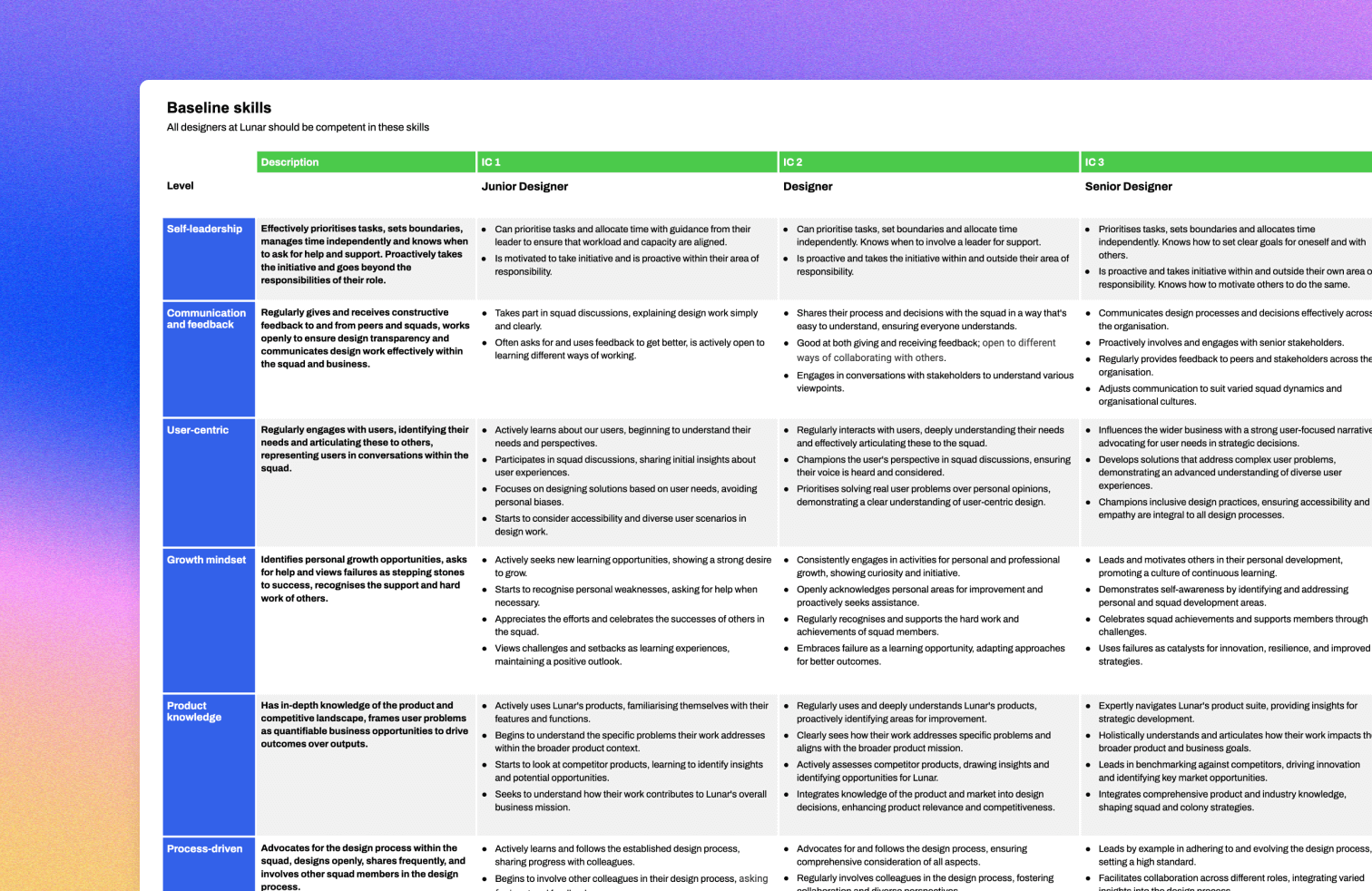Highlights
- Elevated design maturity: Advanced the team from an “emergent” level of design maturity to a more structured and impactful discipline, laying the groundwork for broader organisational alignment.
- Defined roles and expectations: Introduced clear, standardised role definitions and aligned job titles across the organisation, enhancing cross-functional understanding and collaboration.
- Built a competency framework: Developed a detailed Design Competency Framework to guide career growth, enable levelling discussions, and foster individual and team development.
- Aligned processes across squads: Created a unified design process adopted by the organisation, improving consistency, efficiency, and cross-functional collaboration. • Mapped skills for growth: Implemented a skills-mapping process to uncover individual strengths, identify growth opportunities, and inform hiring decisions based on team-wide needs.
- Strengthened team alignment: Fostered clarity, confidence, and shared purpose among designers, resulting in a cohesive and high-performing design team that contributes measurable value to the organisation.
Transforming Design at Lunar
When I joined Lunar as Head of Design, I faced an exciting challenge: elevating the organisation’s design maturity while creating clarity and growth opportunities for an emerging design team.
Elevating design maturity
Challenge
After a period of rapid scaling, Lunar’s design team had grown significantly in size but lacked the structure and processes needed to function as a high-impact discipline. The team was often seen as the group that “made things look good” rather than one that solved user and business problems. Without clarity around their roles or responsibilities, many designers felt uncertain about expectations, contributing to inefficiencies and a limited organisational influence.
Approach
To address these challenges, I conducted an in-depth assessment of the team’s maturity and needs. This involved 1:1 interviews with designers, cross-functional retrospectives, and team workshops to identify gaps in skills, processes, and alignment. I discovered that the team’s maturity aligned with the “emerging” stage of the UX maturity model, with individual designers eager for role clarity and opportunities to grow.
From this insight, I developed a phased strategy:
- Empowering individuals by establishing clear role definitions, skill frameworks, and expectations to provide a sense of direction and security.
- Improving processes to enable the team to operate efficiently and deliver greater value across the organisation.
- Aligning the discipline with broader organisational goals, shifting the perception of design as a strategic partner rather than a service function.
Outcome
The initiatives outlined in this case study—such as skill mapping, competency frameworks, and role definitions—transformed the design team’s capabilities and confidence. Designers gained clarity about their roles and contributions, while the organisation benefited from improved processes and a more aligned, impactful design function. These foundational changes not only addressed immediate needs but also set the stage for continued growth, allowing Lunar’s design team to evolve into a mature, strategic force within the organisation.
Role and skills definition
Challenge
The team lacked a clear understanding of the skills they needed to succeed and how their roles fit into the broader organisation. This gap hindered professional growth and team cohesion.
Approach
I facilitated workshops to map the team’s current and aspirational skillsets, breaking them into Baseline Skills (core competencies all designers should have) and Supplementary Skills (specialist expertise). From there, I developed detailed skill definitions for soft and hard skills, such as communication, strategic thinking, and visual design.
Using these definitions, I created specific role descriptions for Designers, Researchers and Writers. These descriptions standardised expectations, aligned job titles across the organisation, and provided clear paths for development.
Outcome
This process gave every team member a clearer sense of their role, their strengths, and growth opportunities. It also fostered a shared understanding of how the design team contributes to Lunar’s success.
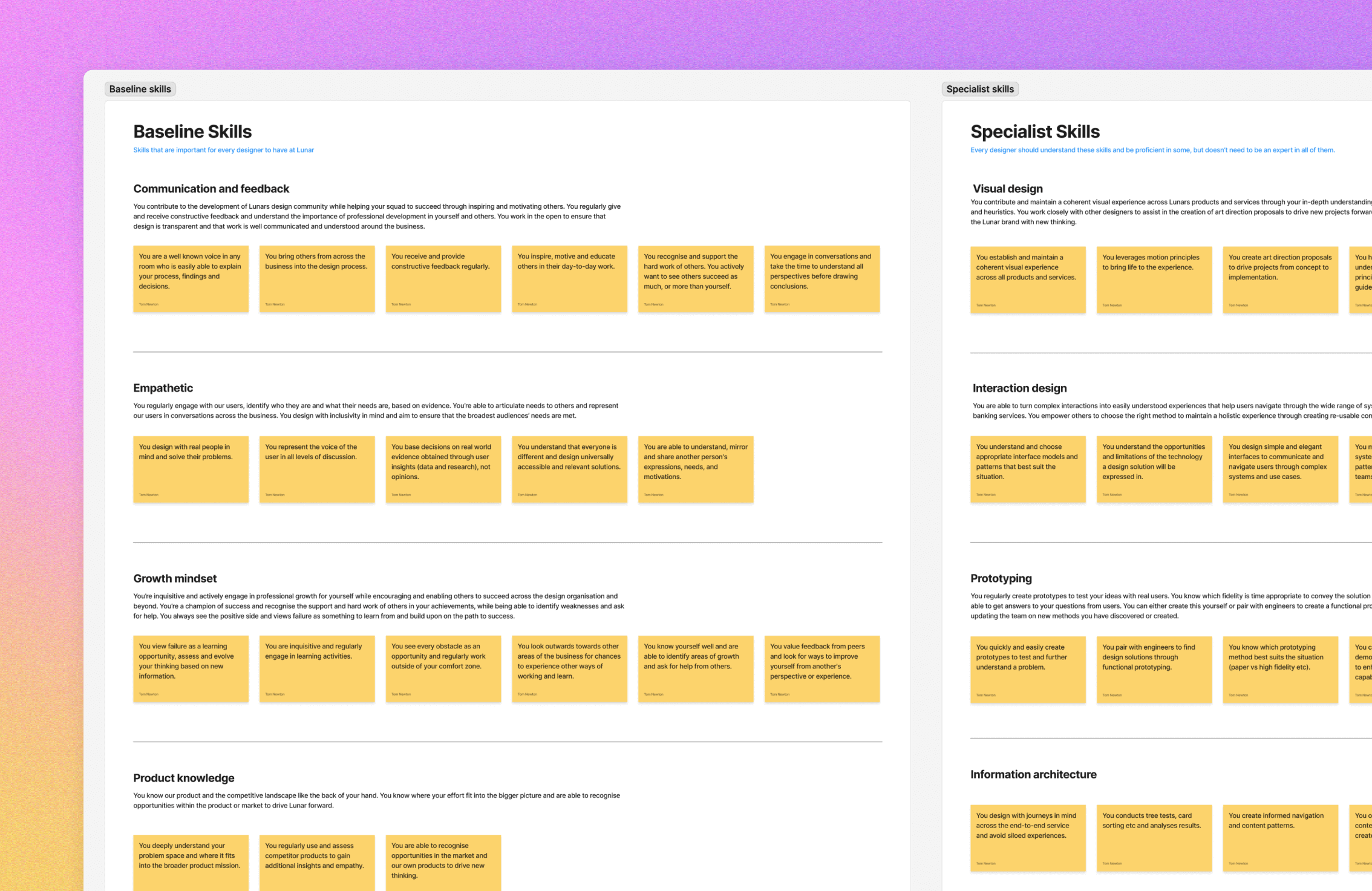
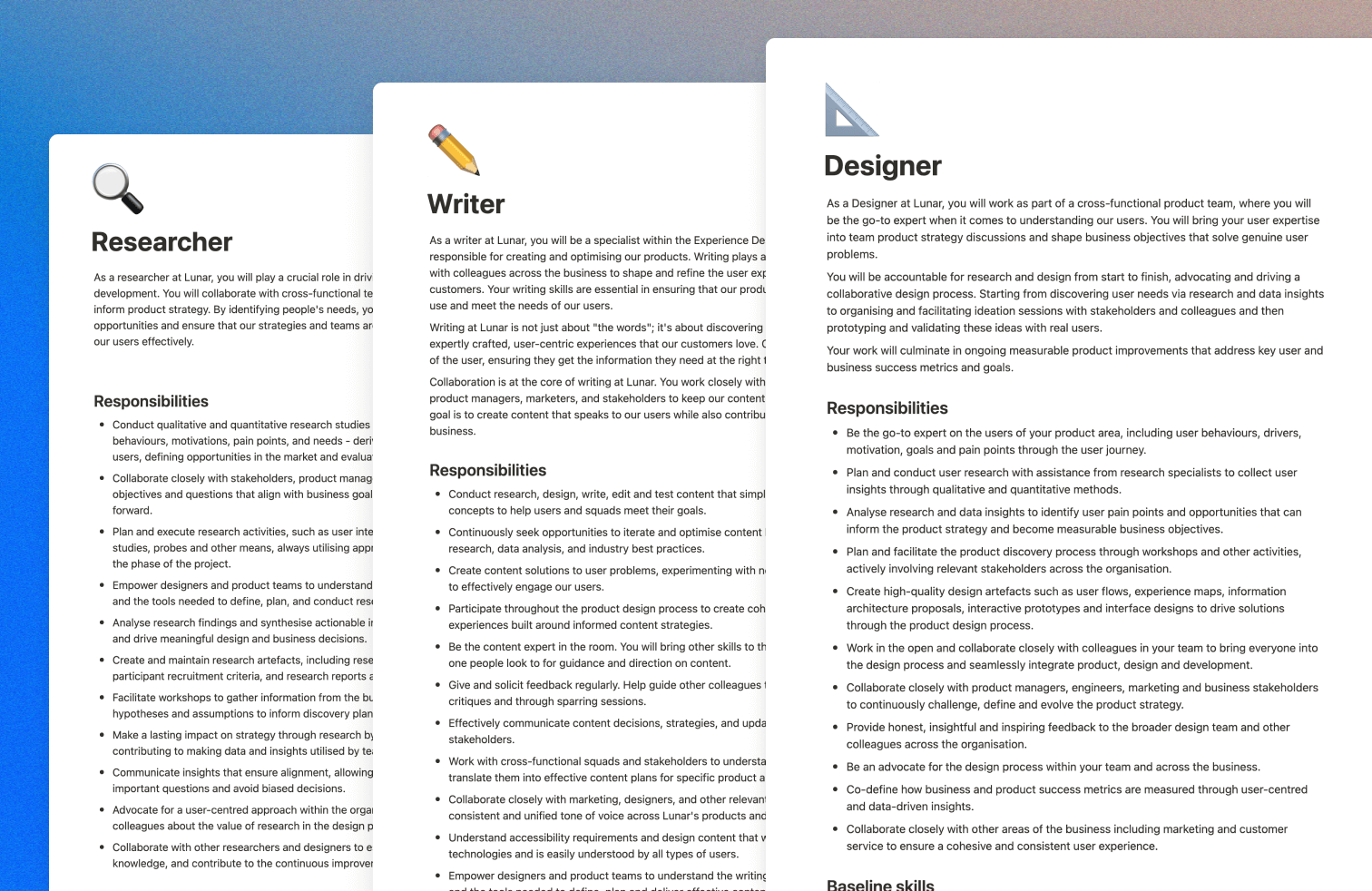
Design competency framework
Challenge
To enable structured growth and career conversations, the team needed a framework that connected skills to levels of proficiency and role expectations.
Approach
I developed a comprehensive Design Competence Framework that detailed skills across levels, from foundational to expert. Each skill highlighted the differences in expectations across each level, allowing team members to understand their current capabilities and chart their development.
Outcome
The framework became a cornerstone of growth conversations, providing designers with actionable insights into their professional trajectory. It also empowered managers to conduct fair and transparent levelling discussions.
Skills maps
Challenge
To ensure the team’s long-term success, I needed to understand each designer’s strengths, growth areas, and overall team composition.
Approach
Using the competency framework, I introduced skills mapping. Designers self-assessed their skills, while peers and managers provided additional evaluations. The skills maps focused not on achieving high scores but on understanding the shape of each designer’s skillset, highlighting areas of specialisation, growth opportunities, and team-wide patterns.
Outcome
This exercise uncovered gaps and strengths at both the individual and team levels. I used these insights to guide hiring decisions, ensuring I brought in complementary skills that aligned with Lunar’s evolving needs.
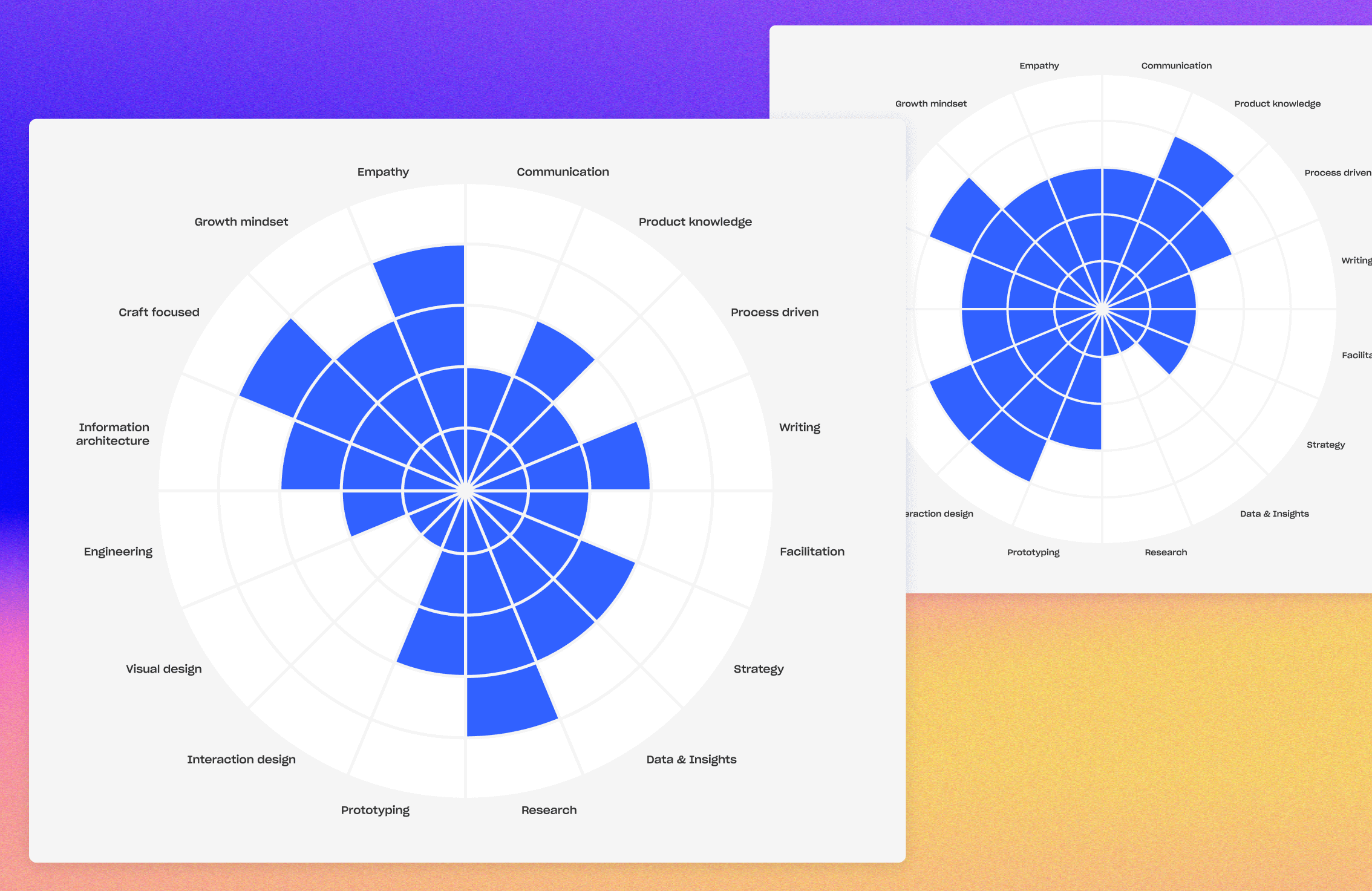
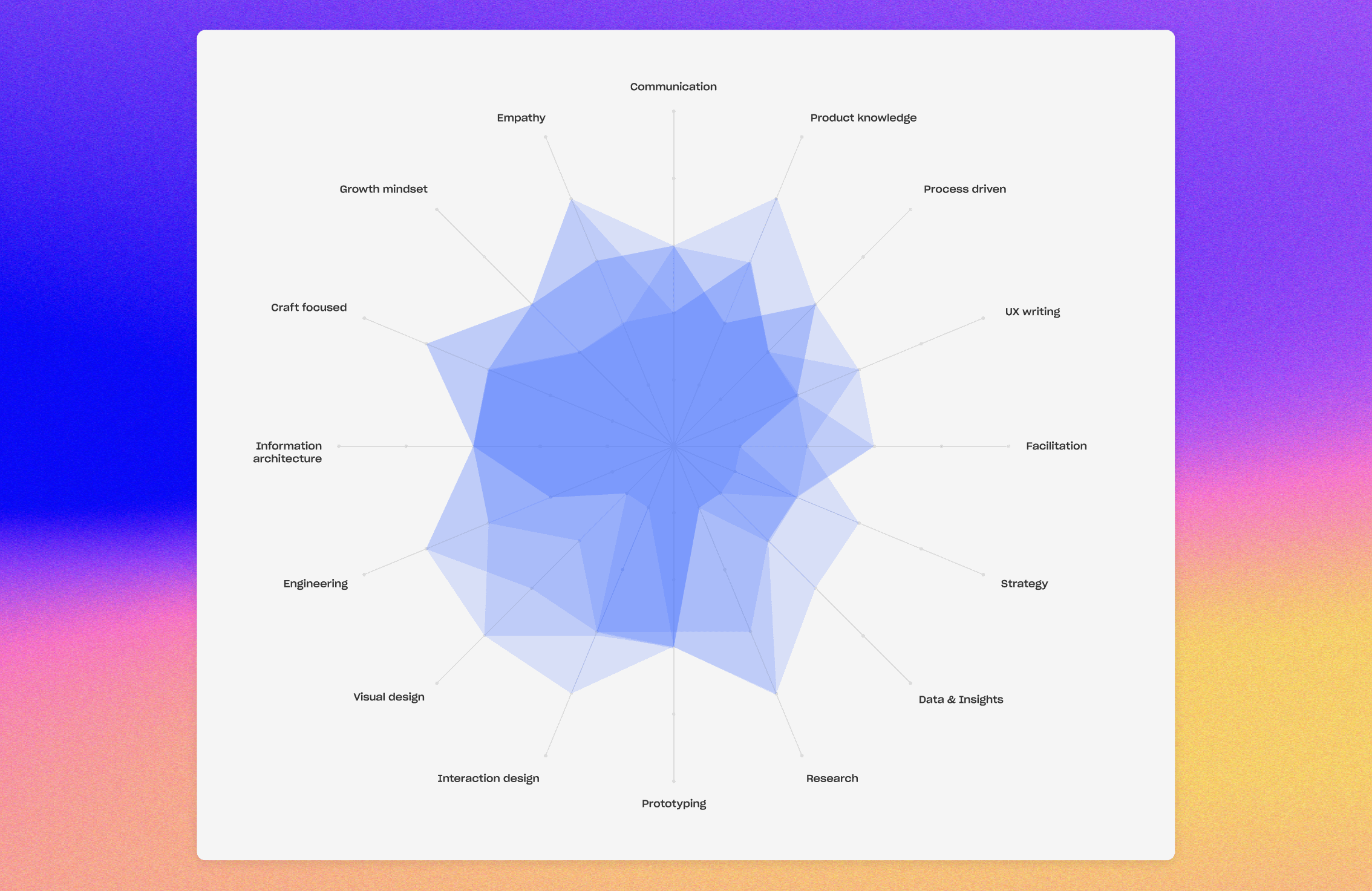
Aligning processes
Challenge
During my initial discovery process, I uncovered a significant challenge within Lunar’s product organisation: inconsistency. Each squad and domain operated with its own unique workflows, and designers had varying approaches to their processes with little cross-team collaboration. This lack of alignment limited opportunities for shared learning, created inefficiencies, and reinforced a perception of design as primarily a delivery-focused function rather than a strategic partner.
Approach
To address this, I initiated a series of design ceremonies aimed at fostering collaboration and alignment within the design team. These included critique sessions, skill-sharing workshops, “Friday Wins” showcases, and the creation of a shared Kanban board to visualise ongoing and upcoming work. These activities helped surface key gaps in collaboration and revealed the need for a unified design process across the organisation.
I tackled this by mapping individual and ideal workflows for each designer. This exercise exposed differences in practice and highlighted opportunities to create a standardised, Lunar-specific process that could address both individual and organisational needs. Designers worked collaboratively to define a shared process framework, complete with clearly articulated stages, goals for each phase, and tailored workshop playbooks to guide teams through discovery, ideation, delivery, and beyond.
By linking the process to the skills maps, I identified areas where designers excelled and where collaboration was essential to cover gaps. This work also clarified a key organisational issue: most designers operated primarily in the “ideation-to-delivery” stages, with limited opportunities to engage in discovery and definition—further perpetuating the narrow view of design’s role.
Outcome
The new, refined process became a cornerstone of Lunar’s design function. Designers began using consistent terminology for each stage, enabling better communication and smoother collaboration during Kanban sessions. The shared process elevated the team’s ability to work cohesively, demonstrate their value as facilitators of strategy, and deliver higher-impact outcomes across squads.
This alignment proved so effective that other departments, including Product Management, Marketing, and Tech, requested similar workshops to adopt the framework for their own processes. As a result, I expanded the shared process into the official “Lunar Process” document, a unified workflow adopted across the organisation. This document enabled teams to speak a common language about their work, streamlined cross-functional efforts, and strengthened organisational efficiency, all driven by design.
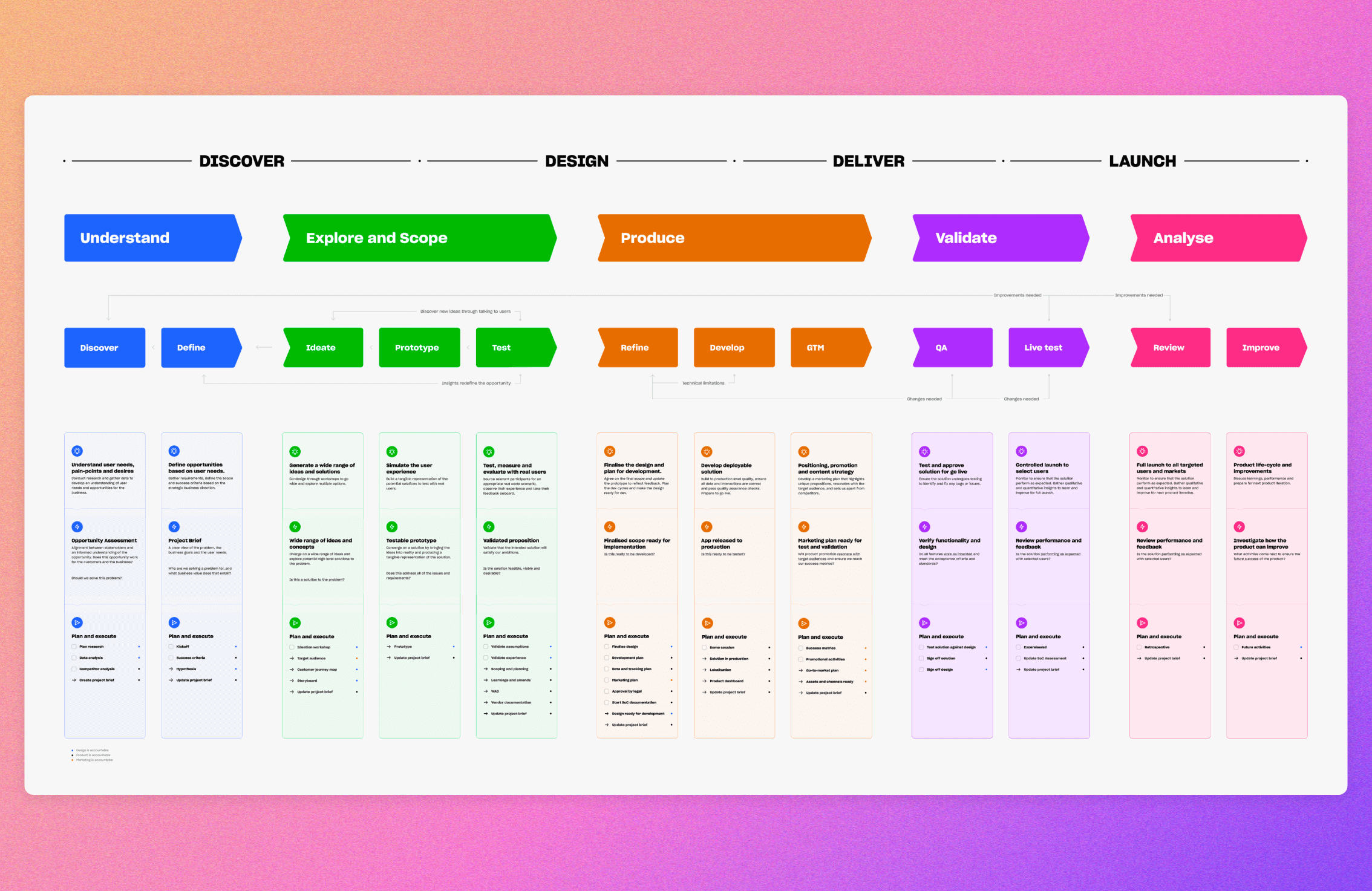
Impact
Through these initiatives, Lunar’s design team transformed into a cohesive, empowered, and strategically aligned function. The establishment of a unified process across squads not only enabled designers to collaborate effectively but also positioned the team as process leaders within the organisation. This work reinforced the value of design as a strategic partner and facilitator, driving innovation and efficiency.
The alignment of processes helped streamline collaboration across teams, creating a consistent language and workflow that improved communication and execution. It also influenced other departments, with Product Management, Marketing, and Tech adopting similar process frameworks to enhance their operations.
Combined with the creation of clear role definitions, competency frameworks, and skills maps, the process work ensured designers had the tools, clarity, and support they needed to succeed individually and as a team. These foundational changes set the stage for sustained growth, ensuring Lunar’s design team remained a high-impact, user-centred function driving measurable business outcomes.
